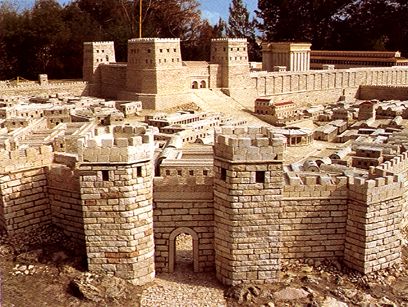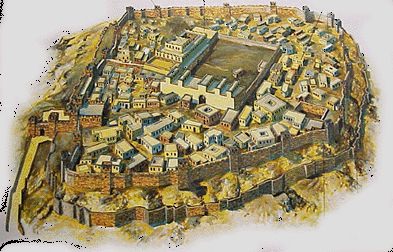from: Israel
Finkelstein / Neil A. Silberman: The Bible
unearthed. Archeology's New Vision of Ancient Israel and
the Origin of Its Sacred Texts; The Free Press, a
division of Simon & Schuster, Inc., 2001; German
edition has got the title "No trombones before Jericho"
(orig. German: "Keine Posaunen vor Jericho"): edition
C.H.Beck oHG, Munich 2002;
Here in this analysis is used the German version "Keine
Posaunen vor Jericho" of DTV, Munich 2004, second edition
of 2005. All page indications refer to the German version.
I hope the page numbers are not very different.
Southern
kingdom of Judah "is taking over" northern kingdom of
Israel
According to the faked OT the southern Reich of
Judah is taking over quasi the full birthright after the
ruin of North Reich of Israel, as if it would be a younger
brother (p.246).
Now
is a strong growth in the Reich of Judah under king
Hezekiah:
There is an influx of refugees - and the prophets of the
collapsed northern Reich have their plans for a 1 god
religion
Since 720 B.C. city state of Jerusalem (biblical "kingdom of
Judah") is growing now rapidly by a wave of refugees from
the occupied northern kingdom of Israel (p.56). There is a
big influx of palace employees, refugees and expelled
farmers of the ex northern kingdom (p.14). Probably under
these refugees are also the northern Israelite
prophets and priests. By this the memory of the destruction
of the North Reich Israel is kept alive (p.244).
Now the warning prophets from the northern Reich of Israel
are claiming more and more a "1 god religion" and want to
realize this plan in the kingdom of Judah now (p.268). These
warner prophets are taking reference to Elia, Elisa, Amos,
and Hosea. They all want to accept only one single god any
more. When there is an occasion they want to perform their
religious cleansing (p.268).
At the same time since 720 B.C. there is coming a movement
of national revanchism. This national movement consists of
Jewish court employees, clerks, priests, farmers, and
prophets (p.12).
The religion of Jewry is not at all fixed yet.
Archeology: Statehood in
southern kingdom of Judah is coming very fast now
According to the findings of archeology the little kingdom
of Judah
-- never had any diplomacy
-- and never has conducted any war (p.250).
In this kingdom of Judah is evoked a great development from
one to the other day (p.56) because Judah has to intercept
the big change after the collapse of the northern Reich of
Israel (p.250), and as another new fact Judah is totally
surrounded by provinces with Assyrian governments or
Assyrian vassals (p.263). Judah is the new Jewish center now
(p.250), becomes the new political and religious center of
the Israelite community (p.263).
Judah is growing and is becoming a local power now (p.57).
The northern city state of Shechem (biblical "northern
kingdom of Israel") is only a memory. Southern city state of
Jerusalem is flourishing now and also developing territorial
ambitions (p.185).
The installation of Judah's political system has got the
following element:
-- statal facilities are installed (p.56)
-- Judah only now introduces annals and a historical
awareness
-- Judah becomes only now a fully developed state with
professional priests and clerks (p.249).
[And always the saying is true: "The last will be the
first", for Egypt, for northern Reich of Israel, for
Assyria, and for all Reichs which will come].
-- there is a rapid population growth (p.250), a population
explosion (p.264)
-- according to archeology Jerusalem only now becomes a
religious center, an Israel Jewish metropolis and trade
center (p.250)
-- Judah is installing it's industry for mass production of
ceramics and olive oil for the export (p.258)
-- Judah is installing an import and export trade (p.250)
-- the trade is managed with ostraka (written clay tablets)
and with weight stones, these are found by archeology
(p.258)
-- illiteracy is overcome, reading and writing is spreading
and written texts suddenly get authority (p.269).
Archeology: Only now there is a
development for building up the city state of Jerusalem in
7th century B.C.
City state of Jerusalem (biblical "kingdom of Judah") is
developing it's buildings only now (p.255), sporadically
(p.266) of blocks of stone with stony capitals (p.177) in
Aeolian similar style ("proto Aeolian") (p.255), whereas the
buildings in Judah are not as big as in the city state of
Shechem, and the quality of the construction is less
(p.177).
|

Model of Jerusalem
in 7th century B.C. with northern city gate,
Damascus gate, and in the background the temple
|
Archeology can exactly state the rapid growth
of Jerusalem (p.263-264). The layout of Jerusalem is
amplified from 4 to 5 hectares to 60 hectares (p.264), this
is about the half of the historic city of today (p.13). The
residential areas are growing on the hills aside the slim
ridge, with a huge town wall saving the new suburbs. The
houses are side by side in a dense way, with workshops and
public buildings. Finkelstein / Silberman estimate that the
number of inhabitants was rising from 1,000 to 15,000
(p.264).
[Speculation: Royalty is taken
over from the northern kingdom
There is missing the report how the kingdom of Judah was
found when David and Solomon had not been kings. It's
possible that the royalty of the northern Reich was simply
taken over in the South. Then king Hezekiah had risen from a
tribal chief to a king, and the refugees of the North had
constructed him the new capital of Jerusalem. Now many towns
get their town walls. Speculations may go on].
Growth in agriculture interior
according to archeology
-- many new farms are founded near Jerusalem
-- in the South of the town and in the Shfela region are
founded new farms on relatively empty soil (p.264)
x
|

 Lachish:
model of the town, at the end with a double town
wall Lachish:
model of the town, at the end with a double town
wall
|
-- villages are growing to towns (p.264),
in the plains are developing medium-sized towns as regional
centers (p.266)
Lachish gets a town wall and is another new administration
center
-- in the bay of Beersheba new towns are founded (p.264).
The map of kingdom of Judah is changing radically now: Judah
in 710 B.C. appr. (in the late 8th century B.C.) has appr.
300 populated locations with all kinds of size, with about
120,000 inhabitants and with a statal structure (p.264). The
characteristics of statehood can all be found:
-- monumental inscriptions
-- seals and seal impressions
-- ostraka (written clay tablets) for the royal
administration (p.266).
Industrialization in the
kingdom of Judah under king Hezekiah according to
archeology
Only now a statal olive oil industry is developed in the
city state of Jerusalem (p.177), and with this a mass
production is connected and a sale of ceramic vessels and
other things. Add to this there is an industry installed
working with oils and wine products under statal leadership
(p.266).
The new wealth in Jerusalem
under king Hezekiah and his successors
The origin of wealth can be found easily:
-- kingdom of Judah has integrated into the economic system
of Assyria
-- kingdom of Judah has probably taken part also in the Arab
trade (p.266)
-- and by this Judah gets new markets (p.267).
All in all since 720 B.C. there is an absolute social and
economical revolution in Judah coming from the economy of
clans to the modern state. Jerusalem is getting a very rich
spot (p.267).
Visits from the ex northern
Reich
Israelits from the ex
northern kingdom of Israel are regularly visiting the cult
celebrations in the temple of Jerusalem (p.242-243).




 Lachish:
model of the town, at the end with a double town
wall
Lachish:
model of the town, at the end with a double town
wall